
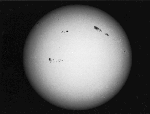 |
| The Sun [click for larger image] |
Sunspots
Sunspots are dark areas of irregular shape on the surface of the Sun. Their short-term and long-term cyclical nature has been established in the past century. Spots are often big enough to be seen with the naked eye. While direct observation of the Sun in a clear sky is painful and dangerous, it is feasible when the Sun is close to the horizon or when it is covered by a thin veil of clouds or mist. Records of naked-eye sunspot observations in China go back to at least 28 BCE. In the West, the record is much more problematical. It is possible that the Greek philosopher Anaxagoras observed a spot in 467 BCE, and it appears that there are a few scattered mentions in the ancient literature as well. However, in the dominant Aristotelian cosmology, the heavens were thought to be perfect and unchanging. A spot that comes and goes on the Sun would mean that there is change in the heavens. Given this theoretical predisposition, the difficulty of observing the Sun, and the cyclic nature of spots, it is little wonder that records of sunspots are almost non-existent in Europe before the seventeenth century. A very large spot seen for no less than eight days in 807 was simply interpreted as a passage of Mercury in front of the Sun. Other mentions of spots seen on the Sun were ignored by the astronomers and philosophers. In 1607 Johannes Kepler wished to observe a predicted transit of Mercury across the Sun's disk, and on the appointed day he projected the Sun's image through a small hole in the roof of his house (a camera obscura) and did indeed observe a black spot that he interpreted to be Mercury. Had he been able to follow up on his observation the next day, he would still have seen the spot. Since he knew that Mercury takes only a few hours to cross the Sun's disk during one of its infrequent transits, he would have known that what he observed could not have been Mercury.
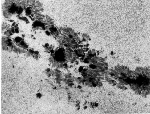 |
| A sunspot [click for larger image] |
The scientific study of sunspots in the West began after the telescope had been brought into astronomy in 1609. Although there is still some controversy about when and by whom sunspots were first observed through the telescope, we can say that Galileo and Thomas Harriot were the first, around the end of 1610; that Johannes and David Fabricius and Christoph Scheiner first observed them in March 1611, and that Johannes Fabricius was the first to publish on them. His book, De Maculis in Sole Observatis ("On the Spots Observed in the Sun") appeared in the autumn of 1611, but it remained unknown to the other observers for some time.
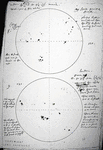 |
| Harriot's sunspot drawings. [click for larger image] |
In the meantime, Galileo had shown sunspots to a number of people in Rome during his triumphant visit there in the spring of 1611. But although some of his corespondents began making regular observations a few months later, Galileo himself did not undertake a study of sunspots until April 1612. Scheiner began his serious study of spots in October 1611 and his first tract on the subject, Tres Epistolae de Maculis Solaribus Scriptae ad Marcum Welserum ("Three Letters on Solar Spots written to Marc Welser") appeared in January 1612 under the pseudonym "Apelles latens post tabulam," or "Apelles waiting behind the painting."[1] Welser was a scholar and banker in Augsburg, who was a patron of local scholars.
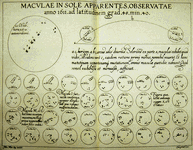 |
| Sunspot plate from Scheiner's Tres Epistolae. [click for larger image] |
Scheiner, a Jesuit mathematician at the university of Ingolstadt (near Augsburg), wished to preserve the perfection of the Sun and the heavens and therefore argued that sunspots were satellites of the Sun. They appeared as black spots when they passed in front of the Sun but were invisible at other points in their orbits. Their orbits had to be very close to the Sun for their shapes were foreshortened as they approached its edge. Scheiner observed sunspots through a telescope equipped with colored glasses.
In the winter of 1611-12, when Galileo received a copy of Scheiner's tract from Welser along with a request for his comments, he was ill, and what little energy he had he was devoting to the publication of his Discourse on Bodies in Water. When, however, that book was at the printer's, in April 1612, he turned his attention to sunspots with the help of his protégé Benedetto Castelli, who was in Florence at the time. It was Castelli who developed the method of projecting the Sun's image through the telescope, a technique that made it possible to study the Sun in detail even when it was high in the sky. Galileo wrote his first letter to Welser on sunspots, in which he argued that spots were, in fact, on the surface of the Sun or in its atmosphere, and although he could not say for certain what they were, they appeared to him most like clouds.
While Scheiner wrote in Latin, Galileo wrote his letter in Italian, and Welser had to have it translated before Scheiner could read it. Scheiner had continued his solar observations, and by the time he had mastered Galileo's letter he had already finished two more letters of his own to Welser. He now added a third, in which he commented that his observations agreed precisely with those of Galileo and defended his judgment that sunspots were solar satellites. This second series of letters was published by Welser in October 1612 under the title De Maculis Solaribus . . . Accuratior Disquisitio ("A More Accurate Disquisition . . . on Sunspots"). Scheiner maintained his pseudonym of Apelles "or, if you prefer, Odysseus under the shield of Ajax." In the meantime, Galileo had written a second letter to Welser in August 1612. In this letter he showed a large number of sunspot observations, made at roughly the same time of the day, so that the Sun's orientation was the same and the motion of the spots across its disk could be easily followed, as is shown in the sequence here. Upon receiving Scheiner's second tract he wrote yet a third, dated December 1612, attacking Apelles's opinions once again. At the end of his last letter Galileo mentioned the Copernican System favorably in a way that some scholars have interpreted as his first endorsement of that theory.
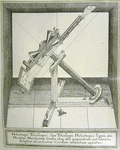 |
| "Helioscopium"
used by Scheiner for his later sunspot observations. [click for larger image] |
Galileo's three letters were published in Rome by the Lyncean Academy in the summer of 1613. About a third of the copies had reprints of the two tracts by Apelles (whose identity had in the meantime become known) in their original Latin. There was little doubt about the winner of this contest. Scheiner's language was convoluted, and not only did Galileo demolish his argument, he also criticized Scheiner's a priori method of argument: the Sun is perfect, therefore it cannot have spots on its surface.
Up to this point, relations between Galileo and Scheiner were not strained. Scheiner had treated Galileo with great respect, and Galileo had been courteous in his language. Ten years later, in his Assayer, Galileo complained about those who would steal his priority of discovery, mentioning the case of sunspots but not mentioning Scheiner. It is almost certain that Galileo was complaining about several others who had published on sunspots but who had not recognized his priority. Scheiner, who at this time was settling in Rome, took Galileo's complaint to be directed at him and became Galileo's sworn enemy.

|
| Sunspot drawings from Scheiner's
Rosa Ursina. [click each for larger image] |
Scheiner had in the meantime published several important books on optics, and he had continued his study of the Sun. He published his results in a massive tome, Rosa Ursina, ("The Rose of Orsini"),[2] which became the standard treatise on sunspots for over a century. Scheiner had abandoned his opinion that spots were solar satellites, and he indeed came out in favor of the system of Tycho Brahe and abandoned the perfection of the heavens. His method of illustrating the motion of individual spots across the face of the Sun became the standard way of rendering this motion and the changing shapes of the spots.
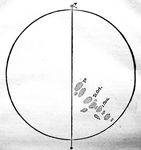 |
| Sunspot drawing by Gassendi. [click for larger image] |
Scheiner's definitive sunspot studies were followed up by others. In France Pierre Gassendi made numerous observations (not published until 1658); in Gdansk Johannes Hevelius (1647) and in Bologna Giovanni Battista Riccioli (1651) did the same. There is, therefore, a reasonably good sunspot record for the years 1610-1645.
After this time, however, sunspot activity was drastically reduced. When, in 1671, a prominent sunspot was observed, it was treated as a rare event. Sunspot activity increased again after about 1710. The period of low activity is now referred to as the Maunder Minimum, after Edward Walter Maunder (1851-1928), one of the first modern astronomers to study the long-term cycles of sunspots. Modern studies of sunspots originated with the rise of astrophysics, around the turn of the century. The chief early investigator of these phenomena in the United States was George Ellery Hale (1868-1938), who built the first spectro-heliograph and built the Yerkes and Mount Wilson observatories, including the 200-inch telescope on Palomar Mountain.
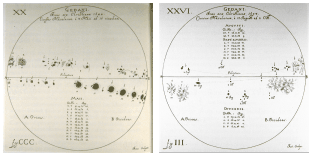
|
| Sunspots drawings by Hevelius. [click for larger image] |
Notes:
[1]Legend has it that the famous Greek painter Apelles once
hid behind one of his painting to hear what people said about it. When a
shoemaker praised the way Apelles had rendered shoes in the painting, Apelles
revealed himself and thanked the shoemaker for the compliment, but this man now
proceeded to give his not so complimentary opinions about other aspects of the
painting. Apelles answered "Let the shoemaker stick to his last."
[2]The rose refers to the Sun, Cardinal Orsini was his patron
who paid for the printing.
Sources: On solar activity in the early seventeenth century, see D. Justin Schove, Sunspots Cycles (Stroudsburg, PA: Hutchinson Ross, 1983) and Kunitomo Sakurai, "The Solar Activity in the Time of Galileo," Journal for the History of Astronomy, 11 (1980): 164-173. On pre-telescopic observations of sunspots, see Schove and George Sarton, "Early Observations of Sunspots?" Isis, 37 (1947): 69-71. A partial translation of Galileo's Istoria e Dimostrazioni intorno alle Macchie Solari e loro Accidenti can be found in Stillman Drake, Discoveries and Opinions of Galileo (Garden City, NY: Doubleday, 1957), pp. 89-144. See also Drake, "Sunspots, Sizzi, and Scheiner," in Galileo Studies: Personality, Tradition and Revolution (Ann Arbor: University of Michigan Press, 1970), pp. 177-199; Keith Hutchison, "Sunspots, Galileo, and the Orbit of the Earth," Isis, 81 (1990): 68-74; Jean Dietz Moss, 'The significance of the Sunspot Quarrel," in Moss, Novelties in the Heavens: Rhetoric and Science in the Copernican Controversy (Chicago: University of Chicago Press, 1993)< pp. 97-125; John D. North, "Thomas Harriot and the First Telescopic Observations of Sunspots," in John W. Shirley ed., Thomas Harriot: Renaissance Scientist (Oxford: Clarendon Press, 1974), pp. 129-165; William R. Shea, Galileo, Scheiner, and the Interpretation of Sunspots (Isis 61 (1970):498-519, and Shea, Galileo's Intellectual Revolution, Middle Years (New York: Science History Publications, 1972); A Mark Smith, "Galileo's Proof for the Earth's Motion from the Movement of Sunspots," Isis 76 (1985): 543-551; Adriaan W. Vliegenthart, "Galileo's Sunspots: Their Role in 17th-Century Allegorical Thinking," Physis, 7 (1965): 273-280.
Images:
Top images: NASA.
Harriot's sunspot drawings: West Sussex Records Office, HMC 241/8, f. 36).
Copyright, Lord Egremont. Reproduced with permission.
Sunspot plate from Scheiner: Tres Epistlae de Maculis Solaribuis
Scriptae ad Marcum Welserum (1612).
Helioscopium and sunspot images: Christoph Scheiner, Rosa Ursina (1630).
Sunspot drawings by Gassendi: Pierre Gassendi, Opera Omnium, 6
vols. (Lyon, 1658), vol. IV.
Sunspot drawings by Hevelius: Johannes Hevelius, Selenographia (1647).
Last updated
Science | Christianity | Library | About | Site Map | Search
Please note: We will not answer copyright requests.
See the copyright page for more
information.










